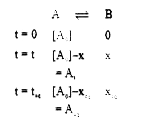Consider a reaction that is first order in both direction
Initially only A is present , and its concentration is . Assume and are the concentrations of A at time 't' and at equilibrium, respectively. The time 't at which ,
The correct Answer is:C

Given at time
and
Now
Topper's Solved these Questions
- QUESTION PAPER 2020Book:KVPY PREVIOUS YEARChapter:QUESTION PAPER 2020Exercise:PART-I (CHEMISTRY )
Explore 20 Videos
- QUESTION PAPER 2013Book:KVPY PREVIOUS YEARChapter:QUESTION PAPER 2013Exercise:PART-II ( CHEMISTRY)
Explore 10 Videos
- SOLVED PAPER 2018Book:KVPY PREVIOUS YEARChapter:SOLVED PAPER 2018Exercise:EXAMPLE
Explore 30 Videos
Similar Questions
2A(g)+B(g)Keq=2×x109⇐=====⇒3C(g)
Initially only A & B are present in the container & moles of A and B at t = 0 are 4 & 2 respectively. If the concentration of A at equilibrium is px×10−q then find p+q−2
Given : Volume of container is 100 lit.
View SolutionFor a first order reaction R→P, the rate constant is k. if the initial concentration of R is [R0], the concentration of R at any time 't' is given by the expression-
View Solution
Knowledge Check
For the reaction AK1⇐===⇒K2B, if 'a' is the initial concentration of A and n is the number of moles of A reacting if initially no B was present then :
Adxdt=[K1(a−x)−K2x] initiallyBK1(a−xe)−K2xe=0 at equilibriumCK1+K2=K1.axeD(K1+K2)=1tln.xexe−xIf [A] is the concentration of A at any time t and [A]0 is the concentration at t=0 , then for the 1st order reaction , the rate equation can be written as _____.
Ak=2.303tlog10[A]t[A]0Bkt=2.303log10[A]0[A]tCk=2.303tlog10[A]0[A]0−[A]tDk=2.303tlog10[A]0−[A]t[A]0For a first order reaction : A→nB (with n-possibly fractional), the concentration of the product varies with time as (A0 is the concentration of A at time t=0).
A[B]=nA0(1−e−2kt)B[B]=nA0tC[B]=nA0(1−e−kt)D[B]=nA0(e−kt)
For a reation: A→ Product,
rate law is −d[A]dt=K[A]0.
The concentration of A left after time t when t=1K is:
View SolutionCo =initial concentration of the reactant Ct = concentration of the reactant at time t, k=rate constant of the reaction. Then the equation applicable for a first order reaction is
View SolutionFor a certain reaction, a plot of [C0−C]C against time t, yields a straight line. C0 and C are concentrations of reaction at t=0 and t=t respectively. The order of reaction is:
View SolutionThe decay constant of radio isotope is λ. If A1andA2 are its activities at times t1andt2 respectively, the number of nuclei which have decayed during the time (t1−t2)
View SolutionFor the consecutive unimolecular first order reaction Ak1−−→Rk2−−→S, the concentration of component A, CA at any time t is given by
View Solution
